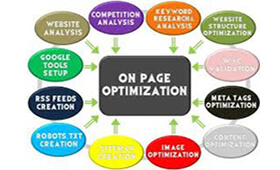
Setting realistic expectations
December 23, 2015
10 Tips for Optimizing Your Images for Search part 2
December 28, 2015Times have changed since the era of dial-up Internet, when users had to wait minutes for a single image to load. Today, we can enjoy fast Internet access—even on our mobile devices. But make no mistake, image optimization for users and search engines is just as important as it ever was, if not more so.
In this article, we will take a look at the many ways you can optimize your images for search engines.
1st Tip. Use the right image
Finding and using the right type of image for your website is an essential step towards success. A great place to start is good old Flickr.com. It has a wide selection of different photos to choose from, along with an ability to filter content by license.
That means that you can easily find a picture that you can legally use for commercial purposes—or even one that has no copyright restrictions.
2nd Tip. Choose the right file format
After you have chosen the right image, you need to decide which file format is optimal for your needs. Since we are mostly concerned with pictures and relatively complicated “photorealistic” graphics, we have to choose from three commonly used raster image formats: GIF, PNG, and JPEG.
- JPEG is the most commonly used image format today. It uses lossy data compression; which means that, depending on your settings, the image quality can suffer quite a bit. There is also no support for transparent backgrounds like there is with GIF and PNG formats. The biggest advantages of using this format is it keeps file sizes small and it is supported almost everywhere.
- GIF is a bitmap image format used for simple art and animations. Because it supports only 256 colors, it’s not recommended for photographs or more photorealistic images. However, its small file size and support for transparent backgrounds make it ideal for company logos and various page elements of websites.
- PNG is a modern alternative to GIF and JPEG file formats. PNG supports transparency, has a better color range, and automatic gamma correction ability. PNG can even store a short text description of the image’s content to help search engines categorize your images. This file format is the newest of all three, which means it’s not so readily supported. Also, file sizes can be a bit larger.
3rd Tip. Optimize your images for the web
When optimizing images for the web, your goal is to reduce the file size as much as possible, without sacrificing too much in terms of image quality.
You have several options, but the easiest means of making this happen is to use an online compression tool like TinyPNG or Compress JPEG. Simply upload your image and the web application will take care of everything for you.
- Use informative file names
For images downloaded from your camera, give them a new name that’s descriptive, making it easier for search engines to find them.
A good example would be something like this: IMG_Los_Angeles_MusicFestival_2015_02.
- Pay attention to alt text
Alt text (short for “alternative text”) is used to highlight the identity of an image when you hover over it with your mouse cursor. It also shows as text to all users when there are problems rendering the image. Additionally, it is used by screen readers that help the visually impaired navigate the web.
The simplest HTML code for an image looks like this:
<img src=”http://example.co.uk/uploads/big-steak.jpg”>
Apart from the file name, search engines visually impaired people have limited information to help them figure out what a web image is about. However, by including alt text like that below, you can precisely describe the content of your picture.
<img src=http://example.co.uk/uploads/big-steak.jpg alt=”Old man eating a big steak in the restaurant”>
You can also look at tags like the “title” property, but a simple alt image tag is enough to tell Google and other search engines what the picture is about—and help you rank better in the SERPs.




